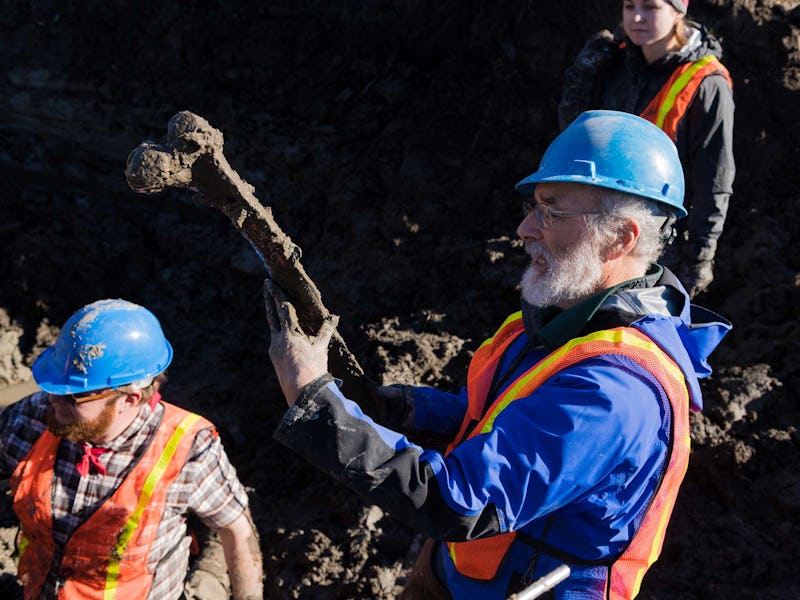Massive Skeleton Suggests Ancient Americans Butchered Wooly Mammoths
Just like us, they kept meat in a 'fridge'.

Paleontologists have unearthed evidence suggesting that ancient humans butchered wooly mammoths and stored the meat for later. At a dig site on a farm near Chelsea, Michigan, a city about 60 miles west of Detroit, a team from the University of Michigan uncovered the remains of one of those mammoths in the remnants of an ancient pond — together with three curiously placed stones that suggested the mammoth was put there on purpose.
The excavation, which took place at the end of November, marked a return to the site for the scientists, who were hoping to recover some missing pieces of a mammoth skeleton they’d partially dug up in 2015. In addition to finding more pieces, the team also examined the sediments surrounding the huge herbivore’s remains, which fill in some of the details of its life and death. Their working theory is that the mammoth, which radiocarbon dating suggests is over 15,000 years old, was purposefully stored in the pond for later eating.
“We think that humans were here and may have butchered and stashed the meat so that they could come back later for it,” said University of Michigan paleontologist Daniel Fisher, who led the dig, in a 2015 announcement.
University of Michigan paleontologist Daniel Fisher, shown here holding a piece of the mammoth's right shoulder blade, says his team suspects that humans butchered the carcass to save for later.
The evidence Fisher cites comprise three boulders, about the size of basketballs, found near the mammoth remains. These stones, the scientists suspect, held the animal’s carcass underwater to keep the meat from spoiling or being stolen — sort of like a Mesolithic refrigerator.
Fisher and his colleague Michael Cherney hand off a mammoth vertebra.
It’s not yet clear whether these early humans killed the mammoth, which was in its mid-40s when it died, or whether they found it dead and refused to let all that good meat go to waste.
The find does change the historical timeline for the region, which had previously placed the earliest human inhabitants in Michigan at 13,000 years ago. But the mammoth butchering evidence could move that timeline back by 2,000 years.
Fisher and his colleagues took soil samples all the way down to get a better idea of what was going on in the region.
The paleontologists had excavated the site hastily in 2015, during which time they found most of a mammoth skull, complete with tusks. But they wanted to revisit this site to recover more evidence, especially after the dating changed what they thought they knew about the region’s history.
In addition to hunting for more chunks of the skeleton itself — which they did find — the paleontologists took samples of the soil for every two inches they dug deeper into the earth. They’re hoping the presence of Sporormiella fungus spores in these samples will help them understand how abundant large grazers were at the time. These spores are concentrated in animal dung, so their presence in the soil gives scientists a good idea of how many grazers were living at the time.
“This return to the Bristle site was absolutely a success. We got the kind of information that we need to do the science right, and we were also able to recover an impressive amount of additional material from this animal,” said Fisher in a statement. “So I’m confident that as a result of this second excavation, we’ll have more insight into what happened here.”
In case you needed more proof dinosaurs had feathers, check out this video of a 99 million-year-old dinosaur fossil.